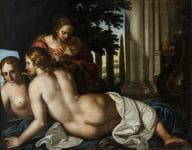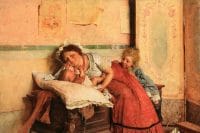At the service of art
The perfect title for this second piece of ours that talks about the restorer Daniela Campagnola (Campagnola Restoration), which, with the example of an important restoration, demonstrates how it is essential to enhance and draw from the knowledge and work of those who, through experience, passion and knowledge, know how to do and do.
This is the intervention on the altarpiece depicting it The Madonna with Baby Jesus, Saint Francis of Assisi, Saint Catherine of Alexandria and Saint Dominic present in the church of Saints Filippo and Giacomo of Cavalcaselle (BS), work di Francesco Lorenzi (Mazzurega di Fumane 1723 – Verona 1787) one of the most important Veronese painters of the eighteenth century and famous pupil of Giovanbattista Tiepolo, of which he is one of the most qualitatively notable followers.
The restoration work on the almost three meter high canvas, which lasted about six months, not only restored its chromatic liveliness, but allowed to make a new reading of the Saints depicted. In the figure that occupies the left part of the painting, until now cited as Saint Anthony the Abbot, the art historian Rita Dugoni has in fact recognized Saint Francis of Assisi.
In this case the intervention was still necessary to allow the painting to be saved from the storage conditions which up to this point had compromised its integrity.
Diffuse cracking, principles of lifting and falling of the paint film in some points and a change in color perception, due to the oxidation and yellowing of old paints and glues used in the past as fixatives are some of the problems that in this case the Dr. Campagnola had to face.
The restoration process went through the fixing of the pictorial film, the re-framing, the cleaning and the integration of the missing parts with watercolors and vertical hatching, choices which indicate the desire to make the intervention carried out recognisable, but which make the gaps present.
We accompany this simple article with two videos that equally simply and linearly show two moments of Dr. Campagnola's work.
We emphasized the word “simple” because the know-how does not always pass through complexity: the description of the restoration, which at first sight may seem, indeed, “simple”, is instead the result of conscious and delicate choices, aimed at making the survival of unique works, which must be treated as such.
Each restoration is different and the decisions to be made are countless; complexity, in reality, is present and manifests itself in many different ways. The gestures that we see performed below, which show the cleaning of a fold of Saint Catherine's dress or the retouching of a fragment lost over time, and which may appear so simple and natural to us, hide years of experience, of studies in-depth knowledge, an awareness of what to do from time to time and how to do it.
Let's rely on those who know how to do their job, only in this way can we continue to enjoy our art.















